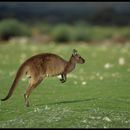en
names in breadcrumbs


The most notable mammal present is the endemic Kangaroo Island Kangaroo (Macropus fuliginosus fuliginosus), the icon for whom the island was named upon European discovery in 1802. A smaller marsupial present on the island is the Tammar Wallaby (Macropus eugenii). An endemic dasyurid is the Critically Endangered Kangaroo Island Dunnart (Sminthopsis aitkeni), which is found only in the west of the island in Eucalyptus remota/E. cosmophylla open low mallee, E. baxteri low woodland or E. baxteri/E. remota low open woodland. The Common Brush-tailed Possum (Trichosurus vulpecula) is a widespread folivore native to Australia.
Monotremes are also represented on the island. There is also an introduced population of the Duck-billed Platypus (Ornithorhynchus anatinus) in the western part of the island in Flinders Chase National Park. The Short-beaked Echidna (Tachyglossus aculeatus) is also found moderately widespread on Kangaroo Island.
Chiroptera species on Kangaroo Island include the Yellow-bellied Pouched Bat (Saccolaimus flaviventris), which species is rather widespread in Australia and also occurs in Papua New Guinea. Australia's largest molossid, the White-striped Free-tail Bat (Tadarida australis) is found on Kangaroo Island. Another bat found on the island is the Southern Forest Bat (Eptesicus regulus), a species endemic to southern Australia (including Tasmania).
Several anuran species are found on Kangaroo island: Brown Tree Frog (Litoria ewingii), Spotted Marsh Frog (Limnodynastes tasmaniensis), Painted Spadefoot Frog (Neobatrachus pictus), Brown Toadlet (Pseudophryne bibroni) and Brown Froglet (Crinia signifera).
The Heath Monitor (Varanus rosenbergi ) is a lizard that grows up to a metre in length, preying on smaller reptiles, juvenile birds and eggs; it is frequently observed on warmer days basking in the sunlight or scavenging on roadkill. The Black Tiger Snake (Notechis ater) is found on Kangaroo Island. Another reptile particularly associated with this locale is the Kangaroo Island Copperhead (Austrelaps labialis).
The Glossy Black Cockatoo (Calyptorhynchus lathami) is found on the island, especially in the western part, where its preferred food, fruit of the Drooping Sheoak, is abundant. The Kangaroo Island Emu (Dromaius baudinianus) became extinct during the 1820s from over-hunting and habitat destruction due to burning.
Marine mammals that are observed on the island include the Australian Sea Lion (Neophoca cinerea) and New Zealand Fur Seal (Arctocephalus forsteri), each species of which is native to Kangaroo Island, and abundant at Admiral's Arch as well as at Seal Bay.
Kangaroo Island is not so adversely impacted by alien species grazers as parts of the mainland. No rabbit species are present on the island, and introduced (but escaped) Domestic Goats (Capra hircus) and pigs (Sus scrofa) have generated only minor issues. However, a Koala (Phascolarctos cinereus) population introduced to the island in the 1920s has caused significant damage to certain woodland communities, especially to Manna Gum trees.
De Kangaroo Island-kangoeroe (Macropus fuliginosus fuliginosus) is een ondersoort (de nominale ondersoort) van de westelijke grijze reuzenkangoeroe (M. fuliginosus) die alleen voorkomt op Kangaroo-eiland voor de kust van Zuid-Australië.
De Kangaroo Island-kangoeroe onderscheidt zich van de westelijke grijze reuzenkangoeroe op het vasteland van Australië door de chocoladebruine kleur van de vacht, die bovendien dikker is. Bij de westelijke grijze reuzenkangoeroes van het vasteland is de vacht grijsbruin van kleur. Verder is de Kangaroo Island-kangoeroe kleiner dan zijn verwant op het vasteland.
De Kangaroo Island-kangoeroe bewoont de eucalyptusbossen en boomsavannes van Kangaroo-eiland. Deze kangoeroe komt op vrijwel het gehele eiland voor, maar de Kangaroo Island-kangoeroe is het meest algemeen in het Flinders Chase National Park in het zuidwesten van het eiland. Habitatverlies door ontginning voor landbouwgrond en sterfte door het verkeer kunnen een bedreiging gaan vormen voor de Kangaroo Island-kangoeroe.
Bronnen, noten en/of referenties